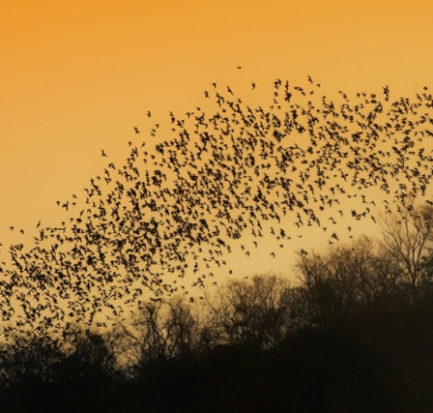The Kasanka Bat Migration could be called the Serengeti of the Skies. This migration involves straw-colored fruit bats that migrate to Kasanka National Park during the later part of the year. Similar to other fruit bats, they have dog like characteristics that include large eyes, long snout, and small ears. The Straw-colored bats are recognized by their pale, tawny fur and vibrant orange necks.
You are invited to discover and learn more about the Kasanka Bat Migration and what makes it one of the Seven Wonders of Zambia.
What makes the Kasanka Bat Migration one of the Seven Wonders of Zambia?
Statistically speaking, the Kasanka Bat Migration involves 5 million Straw-colored fruit bats that migrate into Zambia’s Kasanka National Park. The swamp forest area of the park provides an over flowing array of musuku, mufinsa and other fruits.
The bats start arriving in October before they are in full presence during the months of November and December. Additionally, these bats are the largest bats in southern Africa.
Aesthetically speaking, the bats are active during the day and usually resting in the trees. This is a site in and of itself. The weight of the massive amount of bats clinging to the branches of trees will occasionally break the branch of the tree. As the sun begins to set and dusk has arrived, there is a period of approximately 25 minutes where 5 million bats take to the skies.
Wildlife researcher and author Chris Stuart describes the migration as one of Africa’s greatest wildlife spectacles. The million migrating bats is almost five times as large as the Serengeti wildebeest migration.
What are the best ways to see and experience the Kasanka bat migration?
The best way to experience the Kasanka bat migration is seated some where in the park with a good view of the bats. A common practice is to have a beverage of choice to enjoy while watching the 25 minute parade of bats.
Kasanka also provides aesthetically appealing scenery during the same months as the bat migration. Visitors should find blue skies with occasional thunderstorms, an abundance of wild flowers, and over 400 species of local and migratory birds.
What is Kasanka and the bat migration weather like?
The weather during the migration of the bats in and out of Kasanka varies just a little. November is warmer with high temperatures floating around 53oF (12oC) during the day and dropping to 48oF (9oC) in the evening.
December is a little chillier with temperatures reaching a high 9oF (48oC) during the day and dropping to around 44oF (7oC) in the evening. Although the temperatures are not that much different, visitors should note that as dusk is approaching and the sun is setting, the temperatures will be dropping.
Overall, the Kasanka bat migration weather is fairly chilly. Visitors should plan for jackets or comfortable clothing because you will just be sitting there watching the bats.
When is the best time to visit the Kasanka bat migration?
The window for experiencing the Kasanka bat migration is a short two months occurring in November and December. It is possible to see arriving colonies of bats in October, but the full and massive experience will not occur until the last two months of the year.
How do you get to Kasanka?
Internationally speaking, the majority of travelers will fly to Lusaka, the capital of Zambia. From there, you should expect about a five hour drive to Kasanka National Park. Charter and local flights can be accessed to make the trip shorter.
Photography Tips for capturing the Kasanka bat migration
There are limited insights or tips for photography at Lake Kariba at this time. The bat migration last for 25 minutes, so the best thing you can do is make sure you are prepared. Adjusting your metering and other settings as the sun sits and you get ready for the migration. With the available light getting less, you will plan on higher ISO settings.
A telephoto or zoom lens will allow you capture images of the bats in the trees, but a normal or wide angle lens will let you capture the magnitude of the migration. A wide angle lens will let you lower your ISO settings some, but still good to adjust your settings as dusk approaches making sure you are ready for the encounter with bats.
Further tips and insights will be added as experienced or discovered. If you are a photographer and have insights to share for future photographers visiting Kasanka and the bat migration, please submit them to Seven Wonders through the Contact Page.
